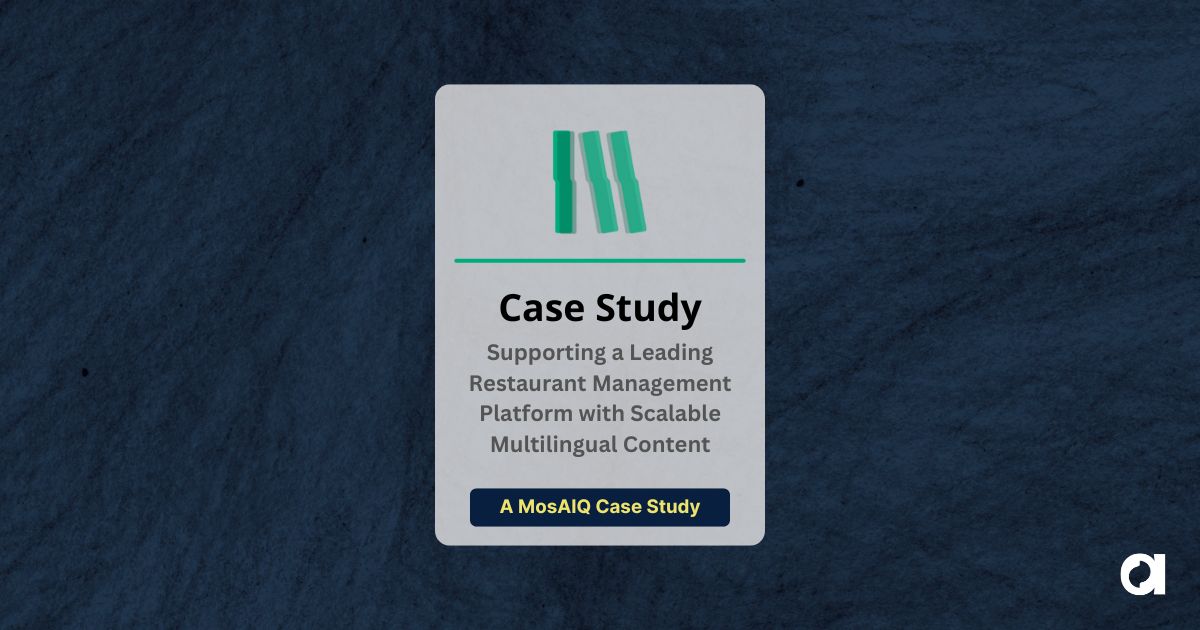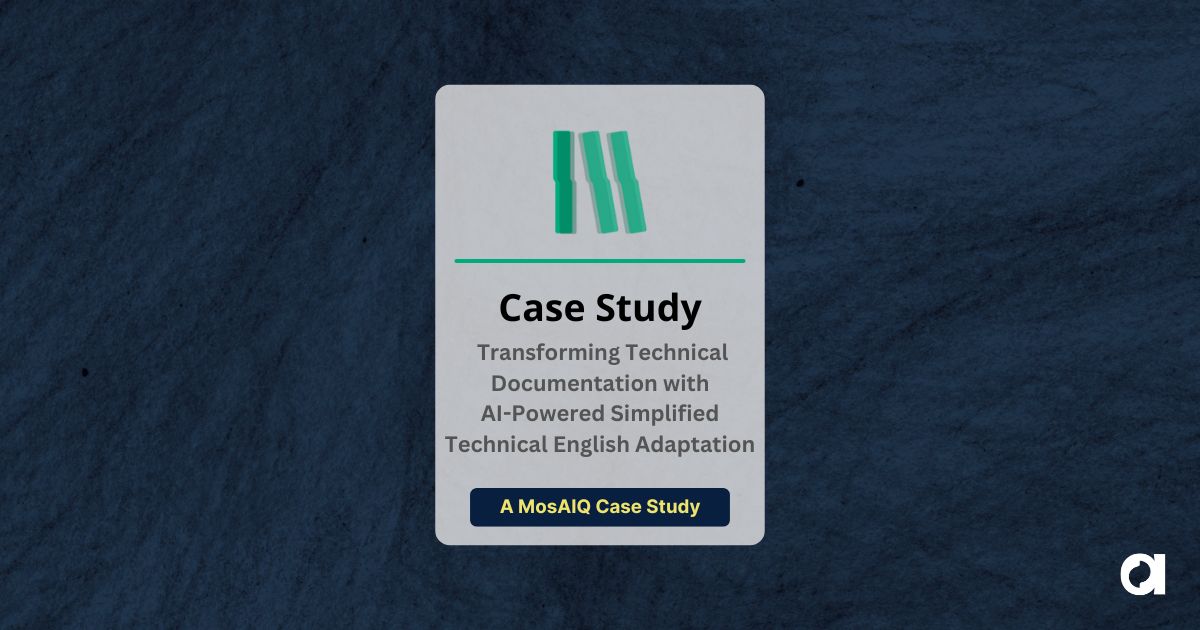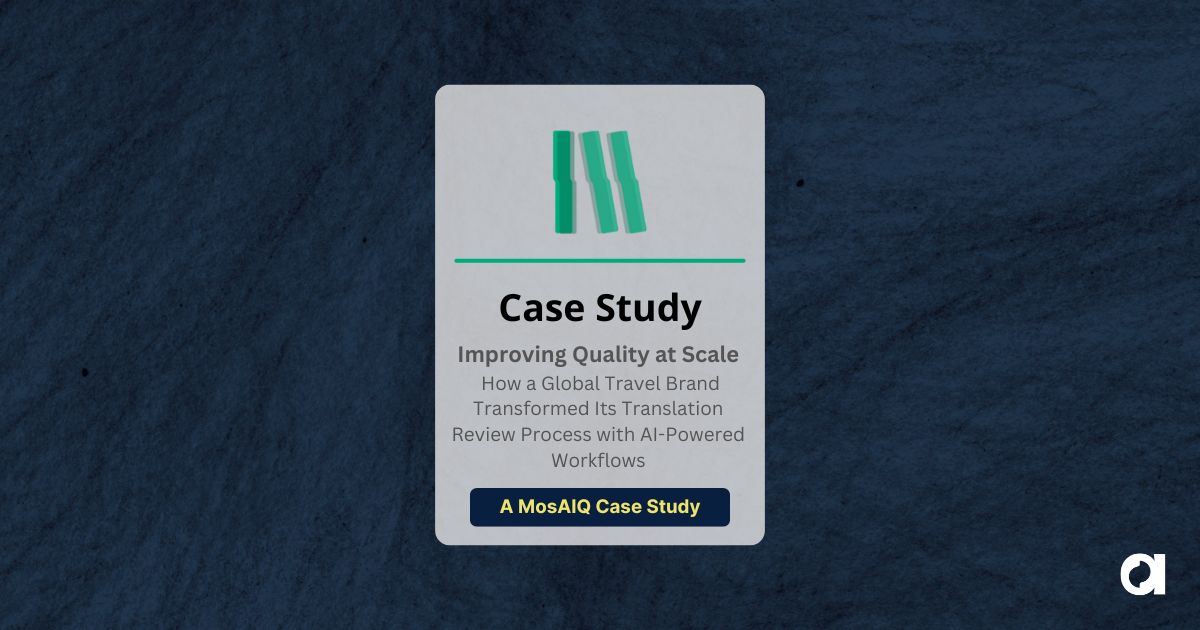AI and Language Infrastructure: Transforming Global Content Delivery
In this insightful discussion with Erik Vogt following TAUS Dublin 2025, we explore the evolving landscape of language services and content delivery. Erik shares key takeaways about the industry’s shift from traditional translation memory systems to AI-driven orchestration platforms, emphasizing how businesses are reimagining their approach to global audience engagement.
Key Topics Covered:
- Language Infrastructure Evolution
- AI Implementation in Content Delivery
- Quality-Cost Trade-offs in Translation
- Content Orchestration and Workflow Innovation
- Customer Relationship Management through Content
Stephanie Harris-Yee: Hello, I am here with Erik Vogt, who just got out of TAUS, Dublin, and we’re gonna be talking a little bit about the top takeaways from the event overall.
So Erik, how was the event and what are your top takeaways from it this year?
Erik Vogt: Sure. Thanks Steph. First of all, I love TAUS. It’s one of the rare cases in which you have a really plugged in audience who are sitting through the same experience for two days and able to not only engage with all of the presentations as they’re being presented in a, it was about 125 or so people but also, so they’re all engaged in that same Q and A and that same experience.
But then there’s also all the side conversations that are stimulated by those conversations. And that kind of creates an incredibly thought provoking two day period. So it’s one of my favorites in that regard. In terms of the key takeaways, there’s definitely some themes. I go to TAUS as regularly as I can, and I’m seeing a couple of important takeaways to me. One of which is that AI is being operationalized and you’re seeing the concrete outcomes of it. So whereas a couple years ago, a lot of the presentations are about what could be. Now we’re seeing what is and what can be shown, proven, demonstrated. So it’s really interesting to see. You’re also seeing different creative approaches on it.
It’s really engaging and really promising to see what’s going on. So that’s just from a practical standpoint. But there’s a couple of technical themes that really popped out. One is that AI-centered orchestration is really redefining the game here. So instead of being translation-oriented, I think we’re really looking at kinda an orchestration in which language is a component. We’re seeing scalability, real time translations. We’re seeing a focus on the adjacent capabilities, not just the translation itself, but we’re seeing an integration between the content creation, the translation, and the interpretation of that translation.
Or rather, maybe more specifically, the end product engagement. So how end customers are dealing with it. So I think that’s pretty exciting. I think it’s also pretty key to see that this is… we have a very fragmented industry, and so the takeaways probably would be very different depending on who you talk to, depending on how they interpret it, what it means for them.
But some of the general patterns that we see across all organizations is that there’s no question that the idea of language infrastructure is changing. So it really is getting away from TMS as the center piece, the keystone. And now we’re talking about other infrastructure components and we hear this theme in other places, right?
We have the idea of lang ops. We have the idea of, putting language infrastructure into a global content delivery ecosystem. When you say it that abstractly it’s, hard to wrap your head around, but some practical applications are knowledge graphs, for example. I think knowledge graphs are, I think going to be an important part of the language assets of the future.
And when you think of translation memories are basically a component of that. Translation memory is source equals target. There’s a, and then maybe some metadata that kind of qualifies the relationship between these two different nodes. The source node and the target node. But then when you think about the other aspects of it, there’s information about the topic… there’s things like glossaries, but there’s also things like the relationship between, or the purpose of the content itself. So you can see file or a sort of a document, for example, has certain characteristics to it that are understood as an entire document.
If you break that down into segments and then translate those segments, you might end up with something a little less optimal for your end use. Then if you took the entire document and you translated the entire document with all that knowledge graph, metadata in there. So to use an example that I used in my panel which was about the global content, providers instead of LSPs, we’re talking about say, you wanted to write a blog piece about how important it is to do your coffee right? And you’re really trying to drive interest in coffee you know, preparing coffee the right way. And maybe in one market you might shoot for a negative one.
Here’s 10 ways you’re ruining your coffee or doing it wrong. But you could direct that to a different market, say in China where I think that style is not as received. you may wanna change it into 10 ways of delighting your friends and family with perfect coffee. Like that kind of a pivot is possible with a deeper understanding of the language itself and the purpose. So you’re thinking about purpose oriented content that can be built essentially fit-for-use, right? So the idea of quality, Renato made a kind of some points about this, in translation, we have a basic anchor, an axiomatic belief that being faithful to the source is your purpose, but it’s faithful to the source at a segment level, and it’s faithful to the source at a kind of a, a very narrow space. But take the next space out. And again, think of the shells outside of the TMS and now you’re thinking about that content. The purpose of that content.
Anyway. Fantastic stuff. Bruno Bitter had the perfect tagline of calling it the flip, you know, where the models are gonna shift from the way our language infrastructure is shifting away from being a TMS centric to being an orchestration-centric with TMS as a critical component of that thought.
That was a really kind of critical take takeaway as well. I think I mentioned this at the top of, my thoughts here, but AI normalization is here. Like we’re, we are now in kind of a post-deployment realm here. So the winners of the innovation challenge, for example, were real implemented AI solutions and there’s different, very impressive ways that people have operationalized this from widely different kinds of places to the different business problems that they’re trying to solve. But they’re oriented around delivering tangible AI capabilities as we’re at it.
Stephanie Harris-Yee: Is there any one thing that you took away from the event that you were surprised of surprised about? Or you hadn’t thought that was gonna be something and then it came and you’re like, oh yeah, that’s actually true. I need to be thinking about this.
Erik Vogt: Well, I think we had a conversation a couple weeks ago about whether fuzzy matches were dead or not.
And in the middle of the conference, I had this panic thought that somehow I had under emphasize the importance this language infrastructure. I realized when I went back and watched… read the transcript that we hadn’t in fact forgotten it all together.
But I can’t emphasize what surprised me was that this is far more important than I thought it was. So it’s, it isn’t just about rethinking the business of global content delivery and, this is a really fundamental rethinking of it, right? It’s not just about how to do translation cheaper.
That’s not the issue. We’re not even talking about machine translation delivering cheaper and cheaper words. We’re talking about a fundamental rethinking of the way that brands engage with their audiences in a myriad of different ways. Now the orchestration concept is really critical as well, because when you think about how, many of the process innovation or opportunities were about routing or about how to manage the flow of things based on metadata associated with it.
So let’s say certain content … has a certain output requirement, you can route it one way in your workflow. You can change your workflow to focus on something else if you need something else. Like it is really, and it I think John Tinsley had a quote in there somewhere, that translation with no errors is not free.
So there, there’s on the one hand, the idea that perfection still requires humans. I mean high quality, let me say, perfection’s a dangerous word but. High quality is still something that requires intensive human effort. And there’s solid performance and control over a wide range of workflows from, a fully curated MT plus AI stack with the appropriate expert prompts and the appropriate context windows and the appropriate, understanding of how to provide the resources needed to optimize that automatic translation on one end of the spectrum.
And then there’s the middle, which is all sorts of different kind of costs to quality trade-offs. And then there’s the perfection part, which is what needs to go into the creation of those fundamental language assets like the TMs you use for training your MT model needed to be really high quality or else you’re training your model with bad habits.
But now you have these other sort of concepts of language, of knowledge graphs and the related infrastructure that goes along with how to provide the best possible communication or content. Content connection between whoever’s trying to get a message across and however that end product is.
I’ll take another example here too that’s interesting to think about. And this came up as well in the second day. I was in a conversation with somebody after the after hours about relationships. And, you know John Gottman, who is a specialist… I don’t know, maybe our audience has heard him, but he’s the love doctor, right?
He’s a PhD who studied relationships. He has a really interesting way of understanding how people have positive versus negative relationships. He said there’s a ratio of one to 20, right? Between any two people. You need to have about 19 positive interactions for every negative one or else the relationship is deteriorating.
And if it’s in a high conflict situation, the ratio is closer to one in five. So for every four sort of positives, one negative. So think about that in terms of your relationship with your customers. Your customers having a bunch of reasonably good interactions with your content And how many negative ones will it take before they break up with you? Before they no longer feel love until they feel that they’re no longer a priority for you.
And when they’re upset and they’re calling into a call center and they need to get something resolved, then their tolerance drops by 75%. So think about that first and then think about the three different channels, three different worlds that we’re in. One is instant translation where your content can be curated and directed to your output streams almost instantaneously.
And there’s plenty of solutions right now for that at some level of quality. And you have on the other end of the spectrum, you have the ability for your end customers to translate what they’re interested in. On their own. Like it’s kind of, you know, click on a button in your browser and you can automatically translate whatever your screen is.
You can even pull out your camera and take a picture of something, and it will automatically translate it for you and maybe even approximate the font that it’s in. It’s really impressive how the end user also has tools that they can deploy on their end. Their expectations are different.
But there’s still two ends of that journey from encoding the information and the intent on one end to the interpretation of the content on the other end. And then there’s this whole world in between. A gain, that cost quality curve where you have all these different sort of assessments of how can you optimize towards a given price point?
How can you deliver content that’s fit for this particular purpose? How can you think about trade offs of how long this stuff is intended to last, or how many people are gonna see it, or what are the consequences of an unhappy customer or at least unhappy with a translation. It’s kind of in some use cases, if it… as long as it’s good enough to make a buying decision, that’s enough.
In other cases it could create a lot of frown, like unhappy face emojis in your customer stream. So, yeah.
Stephanie Harris-Yee: Is there anything else that you wanna leave us with, like one actionable thing for anyone involved in the localization industry to be thinking about or doing after this event?
Well, you know, if you’re not already deploying AI in some way, talk to your suppliers about it because it needs to be in part of your conversation. Look for real live demos, because they exist. And if people can’t show you something real at this point, then they’re, probably not quite on top of things.
Erik Vogt: Slides aren’t good enough. But the third is try things out, experiment. And I can’t say this enough and I say this all the time, but if you don’t know, try. Test things out. Iterate. I think there’s so many different ways that solutions can… obviously some systems are so complex it takes a long time to roll out massive changes. But short assessments don’t have to be overwhelming. So I would say, get in there. Get into the story. Be a part of it. Try things out. Experiment. Learn with experience. This is kind of the key lesson from the people who are making waves at TAUS. That’s what they’re doing.
They’re just plowing into it and trying things out.
Stephanie Harris-Yee: Thank you so much Erik, and yeah, great recap of the event and we’re looking forward to the next one.
 Argos Multilingual
5 min. read
Argos Multilingual
5 min. read
In April 2025, the UK Medicines and Healthcare products Regulatory Agency (MHRA) implemented a revised clinical trials framework following its public consultation on regulatory reform. Sponsors are now expected to submit through the Combined Review, a coordinated ethics and regulatory process with a target timeline of 150 days. It changes what gets submitted, when, and […]

 Stephanie Harris-Yee
11 min. read
Stephanie Harris-Yee
11 min. read
The Evolution of Translation Technology Join Stephanie Harris-Yee and Erik Vogt for an insightful discussion about the future of translation technology and whether fuzzy matches – a long-standing pillar of translation workflows – are becoming obsolete. Learn how AI and machine translation are reshaping the industry’s approach to translation memory and quality assessment. Key topics […]











